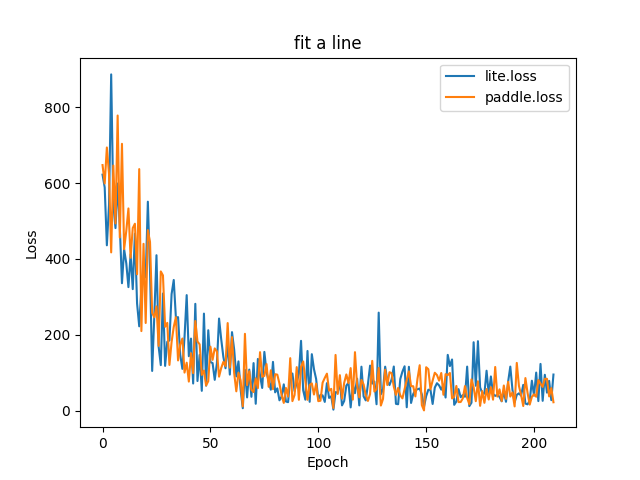C++ Train Demo¶
Introduction¶
我们都知道,Paddle Lite 可以做移动端预测,事实上 Paddle Lite 支持在移动端做模型训练。本文给出使用Paddle Lite 做训练的例子,这一例子对应的任务是“波士顿房价预测”,又称作 “fit-a-line”。
你可以通过 book 库中的 文档 和 源码 进一步了解“波士顿房价预测”这一任务的定义及其建模过程, 其使用线性回归( Linear Regression ) 模型做建模。本文主要介绍如何将其迁移至 Paddle Lite 进行训练。
Requirements¶
一部安卓手机,用于运行训练程序
装了 Paddle (version >= 1.7.0) 的 python
Quick start¶
Step1 build paddle lite¶
请按照 paddle lite 官方文档的教程编译 full_publish 的 paddle lite lib。以 Linux 上编译为例,其具体的命令为:
配置环境
$ wget -c https://mms-res.cdn.bcebos.com/cmake-3.10.3-Linux-x86_64.tar.gz --no-check-certificate
$ tar xzf cmake-3.10.3-Linux-x86_64.tar.gz
$ export PATH=${PWD}'/cmake-3.10.3-Linux-x86_64/bin':$PATH
$ wget https://dl.google.com/android/repository/android-ndk-r17c-linux-x86_64.zip
$ unzip android-ndk-r17c-linux-x86_64.zip
$ export NDK_ROOT=/opt/android-ndk-r17c
编译
$ git clone https://github.com/PaddlePaddle/Paddle-Lite.git
cd Paddle-Lite
$ ./lite/tools/build.sh \
--arm_os=android \
--arm_abi=armv7 \
--build_extra=ON \
--arm_lang=gcc \
--android_stl=c++_static \
--build_train=ON full_publish
产物:
Paddle-Lite/build.lite.android.armv7.gcc/inference_lite_lib.android.armv7/cxx/lib/libpaddle_full_api_shared.so
Step2 编译 lr_trainer¶
$ cd Paddle-Lite/lite/demo/cxx/train_demo/cplus_train/
$ sh run_build.sh /path/to/your/Paddle-Lite/build.lite.android.armv7.gcc/ /path/to/your/android-ndk-r17c
产物:
bin/
`-- demo_trainer
Step3 download model and run it!¶
在你的笔记本电脑上,用 usb 连接到手机,开启开发者模式,在任意目录下执行:
$ local_path=/data/local/tmp/linear_regression
$ adb shell "mkdir "${local_path}
Download model and push to mobile
$ wget http://paddle-tar.bj.bcebos.com/paddle-lite/lite_lr_model.tar.gz
$ tar -zxvf lite_lr_model.tar.gz
$ adb push lite_lr_model/housing.data ${local_path}
$ adb push lite_lr_model/model_dir ${local_path}
Push lib and executable file to moblie
$ adb push libpaddle_full_api_shared.so ${local_path}
$ adb push demo_trainer ${local_path}
$ adb shell chmod +x ${local_path}/demo_trainer
Run it
$ adb shell "export LD_LIBRARY_PATH="${local_path}" && export LIBRARY_PATH="${local_path}" && cd "${local_path}" && ./demo_trainer true"
期望结果:
sample 0: Loss: 564.317
sample 1: Loss: 463.9
sample 2: Loss: 1197.54
sample 3: Loss: 1093.83
sample 4: Loss: 1282.76
sample 5: Loss: 792.097
sample 6: Loss: 491.776
sample 7: Loss: 698.496
sample 8: Loss: 248.445
sample 9: Loss: 325.135
更多细节¶
上面提到的模型是直接下载得到的,如果你想自己生成,可以执行以下命令:
$ git clone https://github.com/PaddlePaddle/Paddle-Lite.git
$ cd Paddle-Lite/lite/demo/cxx/train_demo/
$ python train.py --save_model
产物:
model_dir/
|-- fc_0.b_0
|-- fc_0.w_0
|-- learning_rate_0
`-- __model__
md5sum fc_0.w_0: 2c7b3649b2a9cf7bcd19f8b256ce795d
如果你想生成自己的模型用于训练,可以参考 train.py 中保存模型的方式。
与 Paddle 训练结果做校对¶
前 10 个 Loss 值¶
为了验证 Paddle 与 Paddle Lite 的一致性,我们控制模型参数一致、数据一致、batch size = 1 的情况下,训练10 个 batch, 记录了二者的 loss 值。
python + paddle 命令:
$ fluid train.py --num_steps=10 --batch_size=1
python + paddle 结果:
Train cost, Step 0, Cost 564.317017
Train cost, Step 1, Cost 463.900238
Train cost, Step 2, Cost 1197.537354
Train cost, Step 3, Cost 1093.833008
Train cost, Step 4, Cost 1282.760254
Train cost, Step 5, Cost 792.097351
Train cost, Step 6, Cost 491.775848
Train cost, Step 7, Cost 698.496033
Train cost, Step 8, Cost 248.444885
Train cost, Step 9, Cost 325.135132
c++ 与 paddle lite命令:
$ ./demo_trainer true
c++ 与 Paddle Lite 结果:
sample 0: Loss: 564.317
sample 1: Loss: 463.9
sample 2: Loss: 1197.54
sample 3: Loss: 1093.83
sample 4: Loss: 1282.76
sample 5: Loss: 792.097
sample 6: Loss: 491.776
sample 7: Loss: 698.496
sample 8: Loss: 248.445
sample 9: Loss: 325.135
Loss 曲线¶
控制训练时的 batch size 为 20,每个 epoch 对训练数据做全局 shuffle,训练 100 个 epoch 后,Paddle 和 Paddle Lite 的 loss 曲线对比如下。

如果想复现上述效果,paddle+python 的运行命令为:
$ git clone https://github.com/PaddlePaddle/book.git
$ cd book/01.fit_a_line
$ python train.py
Paddle Lite + c++ 的运行命令为:
$ ./demo_trainer false